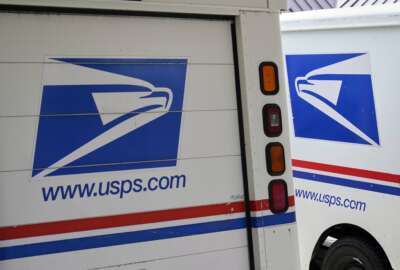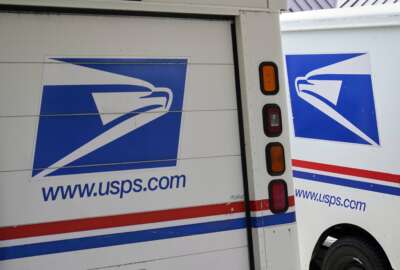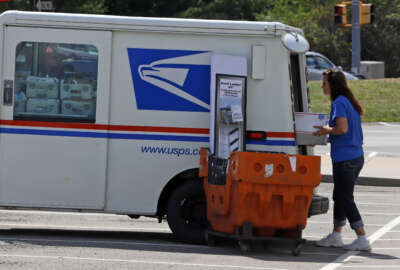USPS outlines its majority-electric vehicle future, as it unveils its first charging stations
The Postal Service is rolling out the first of its new electric vehicle charging stations, and laying the foundation for a majority-electric fleet. USPS on Monday...
The Postal Service is rolling out the first of its new electric vehicle charging stations and laying the foundation for the largest fleet of its kind in the country.
USPS on Monday unveiled its first set of electric vehicle charging stations at the South Atlanta Sorting and Delivering Center (S&DC), which will support its majority-electric future fleet.
S&DCs are large facilities that consolidate the operations of letter carriers and mail handlers under one roof. USPS plans to have 100 of them up and running by the end of this year, and over 400 S&DCs in the next three years.
The fleet project is part of a $40 billion infrastructure investment USPS is making as part of its 10-year “Delivering for America” reform plan.
“The improvements we need to achieve in sustainability are an integral outgrowth of the broader modernization efforts we have undertaken through our 10-year Delivering for America plan,” Postmaster General Louis DeJoy said Monday.
USPS is spending about $10 billion on its new fleet, but Congress gave the agency $3 billion in the Inflation Reduction Act to buy more electric vehicles and charging stations than it could otherwise afford.
USPS says the charging stations are the first of hundreds it will install at new S&DCs across the country throughout this year.
The agency expects to receive its first next-generation vehicles from vendor Oshkosh Defense this summer. USPS will start deploying its electric delivery trucks in Georgia, and then expand to other locations across the country throughout the year.
“As we transform our operating processes and invest in new automation, new technologies, and upgraded facilities and vehicles, we will generate significant efficiencies that reduce our costs, slash our carbon footprint and minimize waste,” DeJoy added.
DeJoy has stressed that S&DCs are critical for the success of a mostly electric next-generation vehicle fleet, because they have the space and infrastructure necessary to charge electric vehicles.
Some older USPS facilities, he said in July 2022, aren’t suited to handle electric vehicle charging infrastructure.
“Most of them I’d be afraid to plug a coffee pot in, let alone an electric vehicle charger,” DeJoy said at the American Enterprise Institute.
USPS also sees its new fleet as an opportunity to deliver packages more efficiently. DeJoy has repeatedly said the agency needs to grow its package business, which competes with private-sector shippers.
Some of the commercially available, off-the-shelf, electric delivery vehicles showcased at Monday’s event have nearly three times the cargo capacity of the aging fleet Grumman Long-Life Vehicles (LLVs) delivery vehicles that USPS currently uses.
USPS expects more cargo space will eliminate the need for letter carriers to make repeat trips to deliver high volumes of packages on their routes.
White House officials support the Postal Service’s electric vehicle investments.
“The work USPS is doing to electrify those vehicles is making EVs commonplace on every road and street in our country, while reducing air pollution and increasing comfort and safety for the dedicated public servants who deliver our mail,” John Podesta, a senior advisor to the president for clean energy innovation and implementation, said in a statement.
White House Council on Environmental Quality Chairwoman Brenda Mallory said USPS investments in electric vehicles are a “victory for the U.S. Postal Service, America’s electric vehicle industry, workers, and the environment.”
“USPS is leading by example by building the world’s largest electric delivery vehicle fleet, and delivering on President Biden’s Investing in America agenda resulting in cleaner air, better health, and good-paying jobs in communities across the country,” Mallory said.
USPS vehicle fleet lawsuit dropped, as agency plans on majority-electric future
Meanwhile, USPS faces fewer legal challenges over plans for its next-generation delivery vehicle fleet.
The Natural Resources Defense Council and the United Auto Workers last week dropped their lawsuit against USPS.
USPS, when the lawsuit was filed in April 2022, planned to replace its current fleet of delivery vehicles with mostly gas-powered delivery trucks.
NRDC and UAW argued USPS failed to take a “hard look” at the long-term environmental impact of a mostly gas-powered fleet and urged them to make a bigger investment in electric vehicles.
But USPS, tapping into $3 billion of funding from the Inflation Reduction Act, is now making electric vehicles a majority of its next-generation fleet.
NRDC Senior Attorney Thomas Zimpleman told Federal News Network in a statement that the organization is voluntarily dismissing its lawsuit challenging USPS’s original 2022 environmental review.
“USPS went back to the drawing board and recognized the benefits of zero-emission vehicles,” Zimpleman said.
Before it received Inflation Reduction Act funds, USPS said electric vehicles would make up at least 10% of the next-generation fleet, and that it would buy more electric delivery vehicles if it could afford them.
USPS currently plans to purchase 66,000 electric vehicles over the next five years, as part of a nearly $10 billion spending plan. In total, the agency expects to purchase 100,000 electric and gas-powered delivery vehicles through 2028.
The agency expects electric vehicles will make up at least 62% of its new fleet. The new fleet is a combination of custom-built delivery trucks from vendor Oshkosh Defense and commercially available vehicles.
“This dramatic change of plans — delivered in part by advocacy from tens of thousands of Americans, members of Congress and the Biden administration — reflects the rapidly changing landscape for electric vehicles,” Zimpleman said.
USPS completed its final supplemental environmental impact statement in June 2023.
“While USPS’s new environmental review leaves substantial room for improvement, it is a step in the right direction. USPS should pledge to purchase even more electric vehicles and ensure that those vehicles are made in unionized factories. NRDC will continue advocating for these and other improvements in electrifying federal vehicle fleets nationwide,” Zimpleman said.
USPS spokesman Jim McKean declined to comment about NRDC and UAW dismissing the lawsuit, but said the agency’s plans for a mostly electrified fleet “is fully compliant with the National Environmental Policy Act and will make the Postal Service one of the nation’s foremost leaders in fleet electrification.”
DeJoy said in December 2022 that USPS will “continue to explore the financial and operational feasibility of achieving 100% electrification for the overall Postal Service delivery fleet.”
“As I have said from the beginning of this journey, the Postal Service needed to replace a 30-year-old fleet of unsafe vehicles, which was specifically designed to do our unique work,” DeJoy said.
Inflation Reduction Act funding, he added, will allow USPS to install charging infrastructure in as many as 500 of its facilities.
Court records show USPS still faces two remaining legal challenges to its fleet modernization plans.
California is leading 15 other states in a lawsuit to prevent USPS from taking any further action under its next-generation delivery vehicle contract, until it conducts a more in-depth environmental review.
EarthJustice is leading other environmental groups —including the Sierra Club, Center for Biological Diversity and CleanAirNow KC — in another lawsuit.
The EarthJustice-led lawsuit claims USPS’ initial environmental assessment favored gas-powered vehicles and was “incomplete, misleading, and biased against cleaner vehicles.”
USPS owns about a third of all federal vehicles and ranks second only to the Defense Department in terms of agencies with the largest vehicle inventory.
The White House said in December 2022 that current USPS fleet plans “will exceed President Biden’s requirement for each agency to electrify its federal fleet.”
Patrick Ecker, USPS’s executive manager for fleet strategy and support, said in a public briefing last summer that USPS expects its new fleet will reduce cumulative greenhouse gas emissions by about 3.9 million metric tons by 2030, and “decrease substantially” its fuel costs.
Ecker expects USPS electric vehicles would be able to travel at least 70 miles on a single charge — its minimum operational requirement, to ensure that letter carriers can complete their routes without the risk of running out of power.
NRDC senior advocate Britt Carmon said during a public comment period that the nonprofit appreciates USPS significantly increasing the percentage of the fleet that will be electric vehicles, but said the plan still “falls short of what’s possible,” and that USPS should set more ambitious targets to reduce greenhouse gas emissions.
“Failure to do so will lock in decades of fossil fuel vehicles operating in these communities,” Carmon said.
Carmon added that USPS could justify buying more electric vehicles if it looked at the total cost of ownership, rather than the initial upfront cost.
Candice Youngblood, attorney at the nonprofit environmental law firm Earthjustice, said USPS’s latest proposal is a “long way” from its initial plan of only making electric vehicles 10% of its custom-built fleet.
Youngblood said USPS’s last electric vehicle plans mark a “critical step toward the federal government meeting the Biden administration’s climate goals,” but urged the agency to lock in its commitment to only purchase electric NGDVs after 2026.
USPS expects all of its new vehicles — both gasoline and electric — will be more sustainable than its current aging fleet.
Ecker said the proposed gasoline-powered vehicles would get 25-44% better gas mileage than the Grumman LLVs they are replacing.
Those LLVs, on average, are 30 years old, and well beyond their expected lifespan of 24 years. Ecker said they are also becoming increasingly costly to maintain.
LLVs also lack modern safety features, including airbags, air conditioning, anti-lock brakes, backup cameras, daytime running lights and windshield wipers.
Copyright © 2025 Federal News Network. All rights reserved. This website is not intended for users located within the European Economic Area.
Jory Heckman is a reporter at Federal News Network covering U.S. Postal Service, IRS, big data and technology issues.
Follow @jheckmanWFED






